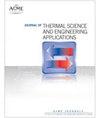Thermal Test Apparatus for Mini Heat Sinks
IF 1.4
4区 工程技术
Q3 ENGINEERING, MECHANICAL
引用次数: 0
Abstract
Demands for more powerful and smaller electronic devices have increased the energy dissipation requirements. Accurate determination of the thermal performance of small sized heat sinks is necessary for innovation within the heat dissipation sector. This study designed, developed, and tested an apparatus for determining the thermal performance of mini heat sinks (MHS). The test apparatus consisted of a wind tunnel, fan, heater, heater block, five temperature sensors, air velocity sensor, and a data acquisition system. A robust dataset was created by testing the heater without a MHS and testing two different MHS materials of polycarbonate (PC) and aluminum (AL) and having 16 to 21 repeat tests. Linear and polynomial approximations for the temperature profile were explored. For the steady state tests, the mean and 90% confidence interval were calculated to determine statistically significant differences. The temperature gradient at the interface, rate of heat transfer, and the thermal resistances from the polynomial fit had higher variation than the linear fit. The experimentally determined heater surface temperature had a 90% confidence interval of ±0.3 to ±0.7°C. The 90% confidence intervals for the thermal resistances were 1.0 to 1.5 K/W for linear and 2.3 to 6.0 K/W for polynomial. Statistically significant differences for the temperature gradient at the interface, rate of heat transfer, and thermal resistances between the bare, PC, and AL were found. Due to heat losses, the linear fit had greater precision, but the polynomial fit had greater accuracy.微型散热器热测试装置
对功率更大、体积更小的电子设备的需求增加了对散热的要求。准确测定小型散热器的热性能对于散热领域的创新非常必要。本研究设计、开发并测试了一种用于确定微型散热器(MHS)热性能的设备。测试设备由风洞、风扇、加热器、加热器块、五个温度传感器、风速传感器和数据采集系统组成。通过测试不带微型散热器的加热器以及聚碳酸酯(PC)和铝(AL)两种不同的微型散热器材料,并重复进行 16 至 21 次测试,创建了一个稳健的数据集。探索了温度曲线的线性和多项式近似值。对于稳态测试,计算了平均值和 90% 的置信区间,以确定统计上的显著差异。与线性拟合相比,多项式拟合得出的界面温度梯度、传热速率和热阻的变化更大。实验测定的加热器表面温度的 90% 置信区间为 ±0.3 至 ±0.7°C。线性热阻的 90% 置信区间为 1.0 至 1.5 K/W,多项式热阻的 90% 置信区间为 2.3 至 6.0 K/W。裸板、PC 板和 AL 板之间在界面温度梯度、传热速率和热阻方面存在明显的统计学差异。由于热损失,线性拟合的精度更高,但多项式拟合的精度更高。
本文章由计算机程序翻译,如有差异,请以英文原文为准。
求助全文
约1分钟内获得全文
求助全文
来源期刊

Journal of Thermal Science and Engineering Applications
THERMODYNAMICSENGINEERING, MECHANICAL -ENGINEERING, MECHANICAL
CiteScore
3.60
自引率
9.50%
发文量
120
期刊介绍:
Applications in: Aerospace systems; Gas turbines; Biotechnology; Defense systems; Electronic and photonic equipment; Energy systems; Manufacturing; Refrigeration and air conditioning; Homeland security systems; Micro- and nanoscale devices; Petrochemical processing; Medical systems; Energy efficiency; Sustainability; Solar systems; Combustion systems
 求助内容:
求助内容: 应助结果提醒方式:
应助结果提醒方式:


